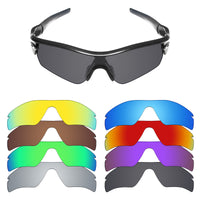-
Shop
Sunglass Replacement LensesFeatured Brands
- For Wiley X
- For Oakley
- For Arnette
- For Bolle
- For Costa Del Mar
- For Dragon The Jam
- For Electric
- For Maui Jim
- For Nike
- For Ray-Ban
- For Revo
- For Rudy Project
- For Smith
- For Spy Optic
- For Von Zipper
AccessoriesWhat's Hot- Rubber Kits
- Sunglass Parts
- Screws & Screwdrivers
- Eyeglass Parts
- Cleaning & Storage
- Search
- Accessories
-
LensesHOT
Top Sunglass ModelsFit for Oakley
- Antix
- Batwolf
- Bottle Rocket
- Crossrange
- EVZero Path
- Fives Squared
- Flak 2.0 XL
- Flak Jacket XLJ
- Frogskins
- Frogskins Lite
- Fuel Cell
- Gascan
- Half Jacket 2.0
- Holbrook
- Jawbreaker
- Latch
- Mainlink
- Oil Rig
- Racing Jacket
- Radar EV Path
- Radar Path
- Si Ballistic Det Cord
- Sliver
- Tailend
- Thinlink
- Turbine
- Turbine Rotor
- Twoface
- Twoface XL
New Arrival - PrescriptionNEW
-
Accessories
-
Contact Us
If you're in the market for a new pair of Oakley sunglasses, you might be wondering what the differences are between the Oakley Radar, Radarlock, and Radar EV models. All three of these sunglasses are popular choices for athletes and outdoor enthusiasts, but they have some key differences that can make one model better suited for your needs than the others. In this article, we'll take a closer look at Oakley Radar vs. Radarlock vs. Radar EV, and help you decide which one is the best fit for you.
Oakley Radar vs. Radarlock vs. Radar EV: What Are the Differences?
Oakley Radar: Features and Benefits
The Oakley Radar sunglasses were first introduced in 2006, and they quickly became a favorite among athletes and outdoor enthusiasts. Here are some of the key features and benefits of the Oakley Radar:
- Lightweight O Matter frame material for all-day comfort
- High Definition Optics (HDO) for superior clarity and impact resistance
- Interchangeable lenses for customizable performance in any environment
- Unobtainium earsocks and nosepads for a secure, no-slip fit
- Three-point fit for precise optical alignment
Oakley Radarlock: Features and Benefits
The Oakley Radarlock sunglasses were introduced in 2012, and they were designed to improve upon the already impressive features of the Oakley Radar. Here are some of the key features and benefits of the Oakley Radarlock:
- Switchlock Technology for quick and easy lens changes
- Lightweight and durable O Matter frame material
- High Definition Optics (HDO) for superior clarity and impact resistance
- Unobtainium earsocks and nosepads for a secure, no-slip fit
- Three-point fit for precise optical alignment
Oakley Radar EV: Features and Benefits
The Oakley Radar EV (short for "extended view") was introduced in 2015, and it takes the features of the Oakley Radar and Radarlock to the next level. Here are some of the key features and benefits of the Oakley Radar EV:
- Extended lens coverage for a wider field of view
- Lightweight and durable O Matter frame material
- High Definition Optics (HDO) for superior clarity and impact resistance
- Unobtainium earsocks and nosepads for a secure, no-slip fit
- Three-point fit for precise optical alignment
Oakley Radar vs. Radarlock vs. Radar EV: Which One Should You Choose?
Now that we've looked at the features and benefits of each model, let's take a closer look at how they compare to each other. Here are some of the key differences between Oakley Radar vs. Radarlock vs. Radar EV:
- Lens interchangeability: While all three models offer interchangeable lenses, the Oakley Radarlock has a unique Switchlock Technology that allows for quick and easy lens changes.
- Lens coverage: The Oakley Radar EV offers the most extended lens coverage, making it a great choice for athletes who need a wider field of view.
- Frame design: While all three models have a similar design, the Oakley Radarlock has a slightly more angular shape than the other two models.
- Price: The Oakley Radar is the most affordable of the three models, while the Oakley Radar EV is the most expensive.
Conclusion
In conclusion, Oakley Radar vs. Radarlock vs. Radar EV all have their own unique features and benefits that make them suitable for different types of activities and sports. If you're looking for a more affordable option, the Oakley Radar is a great choice. If you need quick and easy lens changes, the Oakley Radarlock with its Switchlock Technology is the way to go. And if you're looking for the most advanced model with the most extended lens coverage, the Oakley Radar EV is the way to go. Ultimately, the choice depends on your personal preferences and needs. We hope this article has helped you make an informed decision about which model is right for you.
Leave a comment











